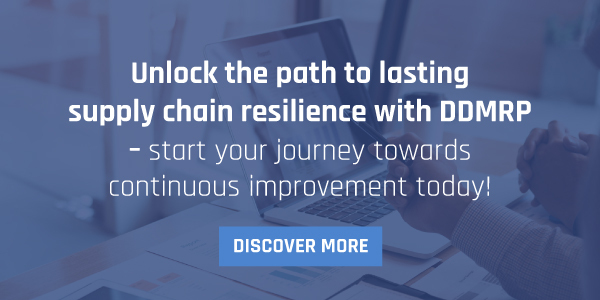
Innovation at Scale: Integrating DDMRP into Large Enterprises for Maximum Agility
March 25, 2024
The Power of Proactivity: Leveraging DDMRP for Demand-Driven Excellence
April 22, 2024In the ever-evolving landscape of supply chain management, the quest for harmony between agility and sustainability has become paramount. As businesses strive to meet dynamic market demands while minimising their ecological footprint, innovative methodologies are needed to synchronise these seemingly divergent goals. Enter Demand Driven Material Requirements Planning (DDMRP), a methodology that not only enhances supply chain agility but also fosters sustainable practices. This article delves into the symbiotic relationship between agility and sustainability within the realm of DDMRP, elucidating how this approach fosters harmony in motion.
Understanding DDMRP: A Catalyst for Change
In the realm of supply chain management, the emergence of Demand Driven Material Requirements Planning (DDMRP) marks a significant paradigm shift from traditional methodologies. Designed to overcome the inherent limitations of conventional Material Requirements Planning (MRP) systems, DDMRP stands as a beacon of innovation, steering organisations towards a more responsive, efficient, and ultimately sustainable mode of operation.
Traditional MRP systems have long been the backbone of supply chain planning, operating on a foundation of forecasts and deterministic planning. This approach, while systematic, often leads to inefficiencies such as overstocking, understocking, and a general lack of responsiveness to actual market needs. The rigidity of relying on forecasts means that when the unpredictable happens—as it often does—the supply chain is left scrambling, resulting in either wasteful overproduction or costly stockouts.
DDMRP presents a compelling alternative by anchoring its strategy in a dynamic, demand driven environment. This methodology pivots on the crucial principle of responding to actual customer demand signals rather than speculative forecasting. By establishing and managing inventory buffers strategically across the supply chain, DDMRP facilitates a nimble response to real-time demand fluctuations. This not only ensures a higher service level but also significantly reduces the risk of excess inventory and the associated waste.
Agility Through Dynamic Buffer Management
In the intricate dance of supply chain management, agility is paramount for success, and Dynamic Buffer Management stands as the choreographer in the performance of Demand Driven Material Requirements Planning (DDMRP). Traditional approaches often stumble upon the bullwhip effect, where minor demand fluctuations reverberate upstream, causing overproduction and inefficiencies. DDMRP steps onto this stage with a transformative solution, strategically placing inventory buffers as the linchpin of its methodology.
The essence of DDMRP lies in its dynamic buffer management system, a departure from the static safety stocks of traditional supply chain paradigms. These buffers, strategically positioned at pivotal junctures along the supply chain, act as shock absorbers against the unpredictability of demand variability and lead time. Unlike rigid, predetermined inventory levels, DDMRP’s buffers are agile, flexing in response to real-time demand signals.
By dynamically adjusting buffer levels, DDMRP orchestrates a delicate balance between responsiveness and efficiency. Imagine a supply chain as a finely tuned instrument, where each buffer harmonises with the rhythm of demand. When demand surges, buffers expand to meet the crescendo, ensuring seamless continuity in supply without the need for frantic reordering. Conversely, during quieter moments, buffers contract, preventing the accumulation of excess inventory and unnecessary costs.
This dynamic interplay empowers organisations to navigate the tumultuous seas of market volatility with grace and precision. Gone are the days of reactive fire-fighting and excessive inventory hoarding. With DDMRP’s dynamic buffer management, supply chains become agile, capable of pirouetting through turbulent market conditions with ease.
In essence, Dynamic Buffer Management epitomises the agility inherent in DDMRP, transforming supply chains from rigid structures to fluid ecosystems of resilience and adaptability. As organisations embrace this dynamic approach, they unlock the potential to synchronise their operations with the cadence of customer demand, ensuring harmony in motion amidst the chaos of the market.

Sustainability Through Waste Reduction
The Demand Driven Material Requirements Planning (DDMRP) methodology emerges not just as a catalyst for agility within supply chains but also as a potent vehicle for sustainability. In the traditional paradigms that have long dictated supply chain operations, the accumulation of excess inventory and engagement in wasteful practices have been significant contributors to environmental degradation. Herein lies the transformative potential of DDMRP—it shifts the focus towards optimising inventory levels based on actual demand rather than speculative forecasts, inherently minimising waste and its consequential ecological footprint.
The dynamic nature of DDMRP is a beacon of sustainability in several key aspects. Firstly, it enhances visibility and control over inventory flows, a critical factor in pinpointing and eradicating inefficiencies that plague the supply chain. This increased oversight means that companies are not just reacting to discrepancies but are proactively managing resources to align with real-time demand, significantly curtailing the need for excessive transportation and storage—activities notorious for their environmental impact.
Furthermore, DDMRP’s approach to streamlining processes extends beyond mere efficiency. By intricately aligning production with actual demand, it directly confronts the issue of overproduction—a prevalent source of waste in traditional supply chains. This alignment ensures that resources are utilised judiciously, with production systems calibrated to generate output that meets demand without surplus, thus mitigating the risk of unsold goods contributing to waste.

The Synergy of Agility and Sustainability
While agility and sustainability are often viewed as conflicting objectives, DDMRP demonstrates how these goals can be mutually reinforcing. By embracing the principles of demand driven planning and dynamic buffer management, organisations can enhance their agility while simultaneously advancing sustainability initiatives. This synergy arises from several key aspects of DDMRP:
1. Resilience Through Flexibility
At the heart of the Demand Driven Material Requirements Planning (DDMRP) philosophy is an unyielding commitment to enhancing supply chain resilience. This resilience is fundamentally achieved through a cultivated flexibility that allows organisations to navigate the unpredictable waters of market demand with agility and confidence. Dynamic buffer management, a cornerstone of DDMRP, plays a pivotal role in ushering in this era of adaptability, serving as a counterbalance to the uncertainties that permeate supply chains.
The traditional model of supply chain management often sees organisations locked into fixed production schedules, predicated on forecasts that can quickly become obsolete in the face of shifting market trends. DDMRP, by contrast, champions a more nimble approach. It acknowledges that in a world marked by rapid changes, the ability to adjust inventory levels in real-time based on actual demand patterns is not just an advantage but a necessity. This flexibility is the linchpin of resilience, enabling organisations to respond to unforeseen changes without the burden of excess inventory or the risk of stockouts.
Moreover, this dynamic adjustment of inventory levels goes beyond mere operational agility. It is a sustainability strategy in its own right. By reducing the likelihood of excess inventory buildup, DDMRP minimises waste, thereby promoting more sustainable supply chain practices. Excess inventory is not just a financial drain; it also represents a squandering of resources—materials, energy, and labour—that could have been better utilised elsewhere.
2. Optimization of Resources
Demand Driven Material Requirements Planning (DDMRP) introduces a strategic framework that transcends conventional supply chain management by advocating for the optimal utilisation of resources. This optimization is rooted in a profound alignment between production, inventory levels, and the genuine pulse of customer demand. Far from the traditional paradigms that often lead to overproduction and burgeoning inventories, DDMRP presents a methodology that is as much about efficiency as it is about sustainability.
At its core, DDMRP operates on the principle that true efficiency is achieved not by maximising output but by synchronising supply with demand. This synchronisation ensures that overproduction—a common pitfall in traditional supply chain models that not only ties up capital but also contributes significantly to waste—is avoided. By steering clear of excess inventory, companies can substantially minimise their environmental footprint, reflecting a commitment to not just economic but environmental stewardship as well.
Furthermore, the strategic allocation of resources under DDMRP is not a static affair but a dynamic one, attuned to the ebb and flow of demand variability. This dynamic approach to resource allocation means that raw materials, energy, and other essential resources are utilised with precision, ensuring that every unit of input contributes to the fulfilment of actual demand. Such meticulous management of resources leads to a reduction in waste, making a significant contribution to sustainability efforts.

3. Collaboration and Transparency
Demand Driven Material Requirements Planning (DDMRP) emerges not just as a methodology but as a catalyst for fostering collaboration and transparency across the supply chain ecosystem. By championing collaboration and transparency, DDMRP transcends traditional silos, enabling stakeholders to work in concert towards common goals of efficiency, resilience, and sustainability.
At its essence, DDMRP functions as a conduit for real-time information exchange, facilitating seamless collaboration among stakeholders. By breaking down silos and fostering cross-functional communication, DDMRP dismantles barriers that hinder effective coordination and decision-making. Through shared visibility into demand signals, inventory levels, and production schedules, stakeholders gain a holistic understanding of supply chain dynamics, enabling them to identify and address bottlenecks and inefficiencies with agility and precision.
Moreover, the collaborative ethos cultivated by DDMRP extends beyond operational efficiency to encompass broader sustainability objectives. By fostering a culture of shared responsibility, stakeholders are empowered to work together towards minimising waste and optimising resource utilisation. This collaborative approach not only enhances supply chain agility but also cultivates a sense of stewardship towards the environment, as stakeholders collectively strive to minimise their ecological footprint.
Case Study : Michelin
Michelin, a French tire manufacturer, is a real world example of the implementation of DDMRP. Michelin adopted DDMRP principles as part of its supply chain strategy to address various challenges, including inventory reduction, service level improvements, and sustainability goals.
Before implementing DDMRP, Michelin faced issues common to large manufacturing operations: excess inventory, complex supply chains, and significant waste generation. These challenges not only impacted Michelin’s operational efficiency but also its sustainability efforts, as excess inventory and waste contribute to higher carbon footprints and environmental degradation.
Michelin embarked on a transformation journey, incorporating DDMRP methodologies to streamline its supply chain operations. The company focused on several key areas:
- Dynamic Buffer Management: By implementing dynamic buffer zones, Michelin was able to adjust inventory levels more accurately based on real-time demand, reducing excess stock and minimising waste.
- Strategic Decoupling Points: Identifying strategic decoupling points allowed Michelin to better manage variability in supply and demand, leading to more efficient use of resources and less overproduction.
- Enhanced Visibility and Collaboration: DDMRP principles helped improve visibility across Michelin’s supply chain and fostered collaboration among different stakeholders. This transparency made it easier to identify and address inefficiencies, further contributing to waste reduction.

Results: The adoption of DDMRP helped Michelin achieve significant improvements in supply chain efficiency and sustainability. Some of the notable outcomes included:
- Reduced Inventory Levels: By optimising inventory management, Michelin was able to significantly reduce its inventory levels, leading to lower storage costs and reduced resource consumption.
- Decreased Waste: Better alignment between production and actual demand helped Michelin minimise overproduction and waste, aligning with its sustainability objectives.
- Improved Service Levels: Enhanced responsiveness to market demand ensured higher customer satisfaction while maintaining sustainable practices.
Michelin’s successful implementation of DDMRP showcases how the methodology can lead to significant sustainability benefits. By reducing waste, optimising resource utilisation, and improving overall supply chain efficiency, DDMRP can help companies achieve their operational goals while advancing their commitment to environmental stewardship. Michelin’s experience serves as a valuable case study for other organisations looking to enhance sustainability through innovative supply chain practices.
Conclusion: Towards a Harmonious Future
In conclusion, Demand Driven Material Requirements Planning (DDMRP) offers a compelling pathway towards harmonising agility and sustainability within the supply chain. By embracing the principles of demand driven planning and dynamic buffer management, organisations can enhance their responsiveness to market dynamics while simultaneously advancing sustainability goals. Through case studies and real-world applications, it is evident that DDMRP serves as a catalyst for change, driving the symbiosis of agility and sustainability in supply chain operations. As businesses continue to navigate an increasingly complex and interconnected global marketplace, DDMRP stands out as a beacon of hope, guiding the way towards a more harmonious and sustainable future.
Learn More About the Intersection of Agility and Sustainability in Supply Chain Management. Get in touch today!





